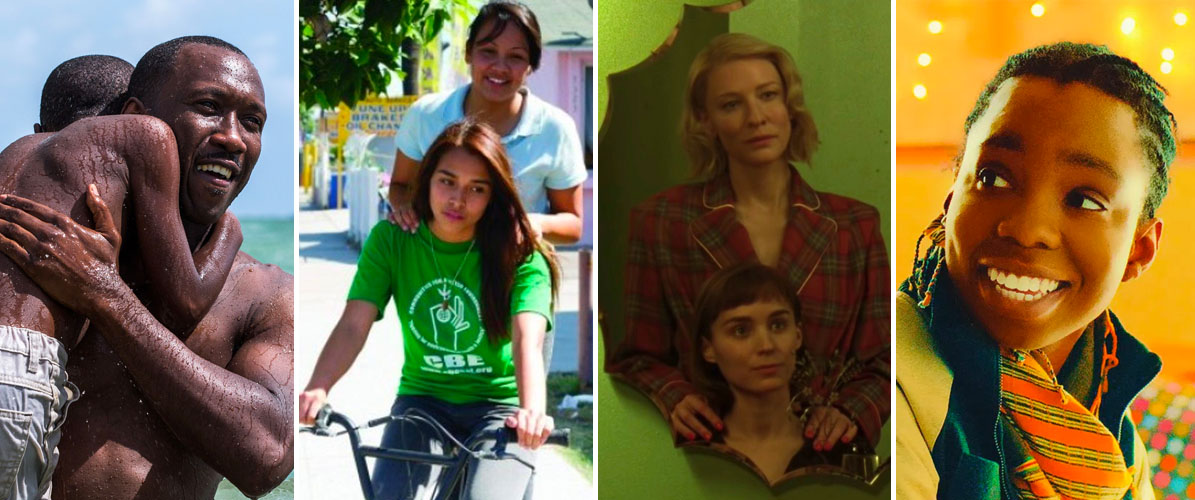
Unit Overview: Drama
Welcome to Unit 2: Drama! In this unit, students will examine four films: Moonlight, Mosquita y Mari, Carol and Pariah.
Moonlight
Students will debate two scholars’ perspectives on the film’s treatment of queer Black masculinity. While L. H. Stallings critiques the film’s rejection of Black femininity, E. Patrick Johnson praises the film’s treatment of “makeshift masculinity.” Readings to accompany Moonlight include:
- Day 2: L. H. Stallings, “Am I A Faggot?”
- Day 3: E. Patrick Johnson, “In The Quare Light of the Moon: Poverty, Sexuality, and Makeshift Masculinity in Moonlight”
Mosquita y Mari
Students will use Whitney Monaghan’s essay to examine how this film disrupts typical “coming out”/”coming of age” narratives and prioritizes what is unsaid over what is spoken, and analyze the film alongside Juana Maria Rodríguez’s examination of gestures and queer Latina femme sexualities. Readings to accompany Mosquita y Mari include:
- Day 2: Whitney Monaghan, “Not Just a Phase: Queer Girlhood and Coming of Age on Screen”
- Day 3: Juana Maria Rodríguez, Introduction to Sexual Futures, Queer Gestures, and Other Latina Longings
Carol
Students will use Victoria L. Smith’s examination of how Todd Haynes constructs heterotopias in Carol through framing, color and other formal elements. Students will also examine Carol alongside Sara Ahmed’s analysis of compulsory heterosexuality and queer affects that develop in response to heteronormativity. Readings to accompany Carol include:
- Day 2: Victoria L. Smith, “The Heterotopias of Todd Haynes: Creating Space for Same-Sex Desire in Carol”
- Day 3: Sara Ahmed, “Queer Feelings”
Pariah
Students will examine dueling perspectives on the narrative’s development of Black motherhood in Pariah, and will apply Audre Lorde’s framework of “the erotic as power” to Pariah. Readings to accompany Pariah include:
- Day 2: Heike Raphael-Hernandez, “‘I am not running, I am choosing’”: Black Feminist Empowerment and the Continuation of a Literary Tradition in Julie Dash’s Daughters of the Dust and Dee Rees’ Pariah
- Day 2: Shoniqua Roach, “Unpacking Pariah: Maternal Figuration, Erotic Articulation, and the Black Queer Liberation Plot”
- Day 3: Audre Lorde, “Uses of the Erotic: The Erotic as Power”
Unit Response Essay
As always, feel free to edit or replace this prompt with one that would best fit your course. Here is a suggested prompt.
Consider the concepts we have addressed in this unit, such as quare studies, resistance to coming out narratives, queer gestures, compulsory heterosexuality, queer discomfort, and the erotic as power. Choose a film from the list below, or consult your teacher about an alternate film choice. Using at least one source we’ve examined in this unit, write an essay of at least four pages in which you examine how the director’s use of cinematic techniques relates to one of the concepts we have examined. Try to address no more than two scenes from the film in your analysis. Remember to provide sufficient descriptions of the scenes you are examining, and analyze them using the language of cinema studies. Be sure to include full citations for all sources. Possible films to examine include:
- Bessie (2015)
- Brokeback Mountain (2005)
- Call Me By Your Name (2017)
- A Fantastic Woman (2017)
- Hedwig and the Angry Inch (2001)
- Milk (2008)
- The Miseducation of Cameron Post (2018)
- Nas & Maalik (2015)
- Portrait of a Lady on Fire (2019)
- Tomboy (2011)
- Viva (2015)